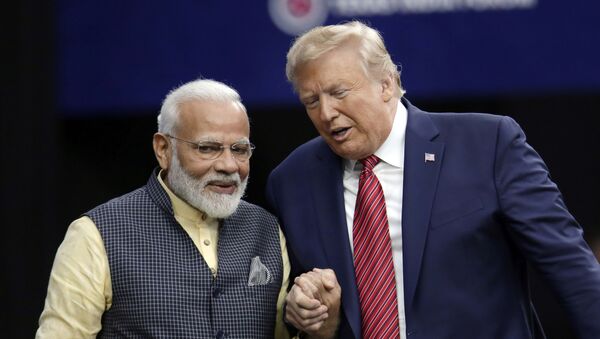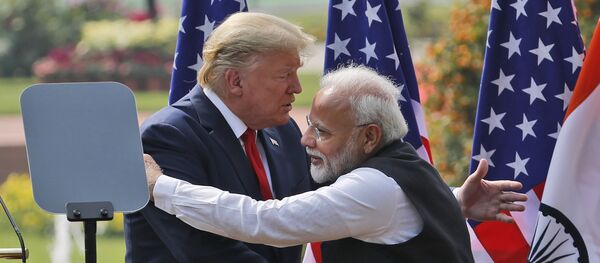The bilateral ties between the US and India might have reached an “unprecedented” level during the four years of Donald Trump's presidency, but former Indian foreign secretary Kanwal Sibal tells Sputnik that the former American leader’s “unpredictability” prevented the relationship from reaching its full potential.
“In India, we can’t overlook the fact that Trump was initially soft on China as he expected to extract trade concessions to serve his domestic policy of bolstering American manufacturing. It was only when Beijing refused to cede to Trump’s demands that he toughened his stance,” says Sibal, who also once served as India's ambassador to Russia.
Sibal points out that in an effort to woo Beijing, President Trump also invited his Chinese counterpart Xi Jinping to Florida’s Mar-a-Lago beach resort just three months after assuming the presidency in 2017. The two leaders came out with a “100-Day Action Plan” geared towards primarily addressing the trade deficit.
“Had China agreed to Trump’s central demands on redressing the trade deficit and concerns around American intellectual property theft by Beijing, he might have released the strategic pressure on Beijing,” explains the ex-diplomat.
While Beijing initially agreed to some of Trump’s demands, including greater access for US companies to the Chinese market, it later refused to comply in the face of increased economic pressure from Washington. The collapse of the 100-Day Plan led to the US-China trade war, resulting in punitive US tariffs on Chinese imports and retaliatory Chinese duties on American goods.
According to US and Chinese government figures, Trump’s trade war led to a further widening of the trade deficit between the two biggest economies between 2016 ($254 billion) and 2020 ($317 billion). Overall, America’s foreign trade deficit was $576.9 billion, as of 2019.
Sibal opines that the goals of US foreign policy under Trump were “more tied” to the economic agenda than under his predecessors, stating that this made him appear “unpredictable” to foreign governments.
“The US knows that India is the only country in Asia that could stand up to China,” underlines Sibal, explaining New Delhi’s increasing prominence in American foreign policy under Trump.
“The warming of ties between India and the US has been guided by a community of interests. Both the governments have had their own reasons,” suggests the former diplomat.
He adds that New Delhi’s strategic interests also served well in getting close to the US, pointing out the recent military face-offs between the two Asian giants. Before the ongoing military face-off in eastern Ladakh, which began in April last year, troops from the two countries were also involved in a standoff at their tri-junction border with Bhutan in 2017.
The same document, which was originally slated to be made public in 2042, also sees cooperation with India as a means to maintain US’ “strategic primacy” in Asia, including maintaining a presence in the world’s “most populous and economically dynamic region”.
In 2020, the last year of his presidency, Trump elevated India-US ties to the level of “comprehensive global strategic partnership” during a visit to New Delhi in February.
The third round of India-US 2+2 Dialogue just around a week before the US Presidential vote on 3 November was followed by the resumption of the four-nation naval drills (India, US, Japan and Australia) in the Arabia Sea and the Bay of Bengal after a hiatus of 11 years.
Modi Managed Friction “Exceedingly Well”
Despite the ever warmer bilateral ties, Trump had been consistently critical of India’s import duties on American goods and had even called the South Asian country “king of tariffs” in 2019.
The US goods and services trade deficit with India was $28.8 billion in 2019, up by nearly 11 percent the previous year, as per Office of the US Trade Representative.
Sibal squarely credits Prime Minister Narendra Modi for managing the differences with Trump “exceedingly well” and "not letting trade disputes affect the overall strategic framework” of the broader ties.
As part of his outreach towards Trump, the Indian leader featured in two public meetings with his American counterpart and all but endorsed a re-election for the former US President. The first public meeting, 'Howdy Modi', was organised in Houston during Modi's visit to the US in September 2019. A similar event, 'Namaste Trump', was held during the American leader's visit to India in February last year.
Calling the India-US economic relationship a “weak link” in a paper published this month, the Centre for Strategic and International Studies (CSIS), a Washington-based think tank, said in a research paper that “the pace of India’s imposition of trade barriers quickened dramatically once the Modi government took office in May 2014”.
The CSIS has also noted that the US' historic decision to strip India of its Generalised System of Preferences (GSP) status in 2019 was a retaliatory measure by the Trump administration. Under GSP, several developing countries are entitled to duty-free access for their exports to the American market.
“Any US president will have to respect New Delhi’s vision to be economically self-reliant by boosting domestic manufacturing,” says Sibal, as he takes note of Modi’s ‘Atmanirbhar Bharat’ (self-reliant India) vision, which the Indian leader announced last year.






